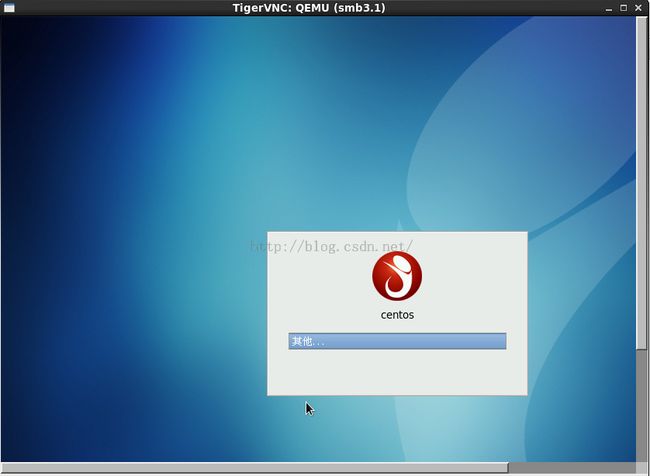kvm虚拟机vnc和spice配置
一、简介
通过vnc或spice方式访问虚拟主机上的KVM虚拟机,可以直接通过图形化界面virt-manager来设置,但此处通过xml配置文件修改。
二、详解
1、VNC方式访问
vnc方式访问虚拟机不是在kvm虚拟机安装配置vnc服务器,通过虚拟主机的IP地址与端口进行访问,kvm虚拟化对vnc的支持相对来说比xen要好很多,在虚拟主机上配置VNC访问虚拟机,也是为了多提供一种方式访问虚拟机而已。(1)修改qemu.conf(也可不修改,默认是127.0.0.1)
#vi /etc/libvirt/qemu.conf vnc_listen = "0.0.0.0"vnclisten默认绑定127.0.0.1,在配置文件里指定VNC绑定0.0.0.0,就不用在安装kvm虚拟机时指定vnclisten参数了。当在虚拟主机上有很多个虚拟机的时候,若指定每个虚拟机的端口,将会很乱,所以采用0.0.0.0自动分配端口。
(2)修改目标虚拟机 smb3.1的配置文件
#virsh list --all
#virsh edit smb3.1
<graphics type='vnc' port='-1' autoport='yes' listen='0.0.0.0'>
<listen type='address' address='0.0.0.0'/>
</graphics>#virsh start smb3.1
(3)查看运行虚拟机的vnc端口
查看vnc端口#netstat -tunlp
也可以通过virsh命令动态查看虚拟机的xml配置文件#virsh dumpxml smb3.1

(4)vnc登录
windows下可以通过vnc viewer或TightVNC或RealVNC等工具登录。

linux下可以安装tigervnc,然后通过#vncviewer 127.0.0.1:5901登录。

linux下也可以通过#virt-viewer --connect qemu:///system smb3.1访问,非本机的linux通过#virt-viewer qemu+ssh://[email protected]/system smb3.1访问。
(5)vnc源码登录
kde桌面的源码包kdenetwork中可以找到krdc/vnc中关于vnc的源码,提取vncview.cpp、vncclientthread.cpp和remoteview.cpp即可运行vnc。
#include "widget.h"
#include "vncview.h"
Widget::Widget(QWidget *parent)
: QWidget(parent, Qt::WindowMinimizeButtonHint | Qt::WindowCloseButtonHint)
{
resize(900+20, 900+20);
VncView *vncView = new VncView(this, QUrl("vnc://:@192.168.40.125:5901"));
vncView->enableScaling(true);
vncView->scaleResize(900, 900);
vncView->show();
vncView->start();
}
Widget::~Widget()
{
}

2、SPICE方式访问
(1)修改目标虚拟机smb3.1的配置文件#virsh list --all
#virsh edit smb3.0
<graphics type='spice' autoport='yes' listen='0.0.0.0'>
<listen type='address' address='0.0.0.0'/>
</graphics>
#virsh start smb3.0
(2)查看运行虚拟机的vnc端口
#netstat -tunlp
a
或通过virsh命令动态查看虚拟机的xml配置文件#virsh dumpxml smb3.0
![]()
(3)spice登录
linux下通过#virt-viewer --connect qemu:///system smb3.0登录到图形化界面。
也可以通过命令#spicy -h 127.0.0.1 -p 5900(需安装spice-gtk-tools软件包)。
(4)spice源码登录
spice-gtk提供了完整的gtk界面。
#include <stdio.h>
#include <stdlib.h>
#include <getopt.h>
#include <gtk/gtk.h>
#include <spice-channel.h>
#include <spice-session.h>
#include <spice-widget.h>
static GtkWidget *main_window;
static SpiceSession *spice_session;
static SpiceDisplay *spice_display;
static char *host;
static char *port;
static void channel_new(SpiceSession *s, SpiceChannel *c, gpointer *data)
{
int id = 0;
g_object_get(c, "channel-id", &id, NULL);
if (SPICE_IS_MAIN_CHANNEL(c)) {
fprintf(stdout, "new main channel\n");
return;
}
if (SPICE_IS_DISPLAY_CHANNEL(c)) {
fprintf(stdout, "new display channel (#%d), creating window\n", id);
spice_display = spice_display_new(s, id);
gtk_container_add(GTK_CONTAINER(main_window), GTK_WIDGET(spice_display));
gtk_widget_show_all(main_window);
return;
}
}
static void usage()
{
fprintf(stdout, "spice-client: A spice client\n"
"Usage: spice-client [options]...\n"
" -h, --host\n"
" Set address of spice server\n"
" -p, --port\n"
" Set port of spice server\n"
" -e, --help\n"
" Print help and exit\n"
);
}
static void parse_cmd(int argc, char *argv[])
{
int c, e = 0;
if (argc == 1) {
usage();
exit(1);
}
const struct option long_options[] = {
{ "help", 0, 0, 'e' },
{ "host", 0, 0, 'h' },
{ "port", 0, 0, 'p' },
{ 0, 0, 0, 0 },
};
while ((c = getopt_long(argc, argv, "eh:p:",
long_options, NULL)) != EOF) {
switch (c) {
case 'e':
goto failed;
case 'h':
host = optarg;
break;
case 'p':
port = optarg;
break;
default:
e++;
break;
}
}
if (e || argc > optind) {
goto failed;
}
if (host == NULL || port == NULL) {
fprintf(stderr, "No host or port found\n");
goto failed;
}
return ;
failed:
usage();
exit(1);
}
int main(int argc, char *argv[])
{
parse_cmd(argc, argv);
gtk_init(&argc, &argv);
main_window = gtk_window_new(GTK_WINDOW_TOPLEVEL);
spice_session = spice_session_new();
g_object_set(spice_session, "host", host, NULL);
g_object_set(spice_session, "port", port, NULL);
g_signal_connect(spice_session, "channel-new",
G_CALLBACK(channel_new), NULL);
if (!spice_session_connect(spice_session)) {
fprintf(stderr, "spice_session_connect failed\n");
exit(1);
}
gtk_main();
return 0;
}
gcc -o spice-client client.c `pkg-config --cflags --libs spice-client-gtk-2.0` ./spice-client -h 127.0.0.1 -p 5900

三、总结
(1)上述代码仅仅是测试代码,若要功能完善还需比较多的工作。(2)参考:http://mathslinux.org/?p=228、http://mathslinux.org/?cat=39。
(3)若有问题或建议,请留言,在此感谢!